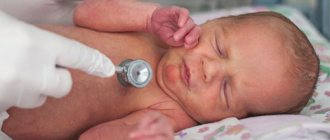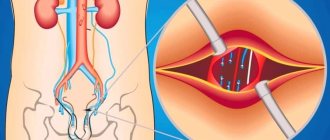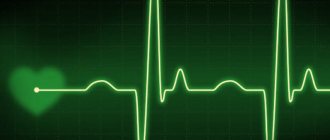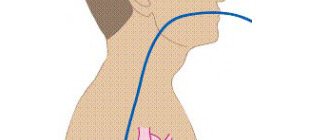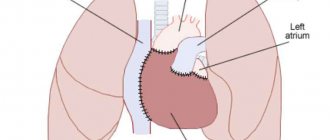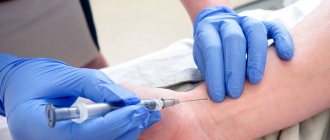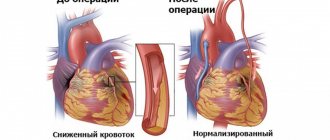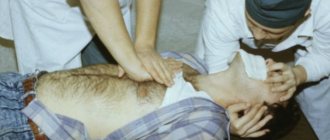Artificial respiration (AR) is an urgent emergency measure if a person’s own breathing is absent or impaired to such an extent that it poses a threat to life. The need for artificial respiration may arise when providing assistance to those who have received sunstroke, drowned, suffered from electric current, as well as in case of poisoning with certain substances.
The purpose of the procedure is to ensure the process of gas exchange in the human body, in other words, to ensure sufficient saturation of the victim’s blood with oxygen and the removal of carbon dioxide from it. In addition, artificial ventilation has a reflex effect on the respiratory center located in the brain, as a result of which independent breathing is restored.
Mechanism and methods of artificial respiration
Content:
- Mechanism and methods of artificial respiration
- Indications and contraindications
- Preparing for artificial respiration
- Artificial respiration from mouth to mouth
- Artificial respiration from mouth to nose
- How long does artificial respiration last?
- Features of the procedure in children
- Manual methods of artificial respiration
- Hardware artificial respiration methods
- Complications of artificial respiration
Only through the process of breathing does a person’s blood become saturated with oxygen and carbon dioxide is removed from it. After air enters the lungs, it fills the lung sacs called alveoli. The alveoli are pierced by an incredible number of small blood vessels. It is in the pulmonary vesicles that gas exchange takes place - oxygen from the air enters the blood, and carbon dioxide is removed from the blood.
If the body's supply of oxygen is interrupted, vital activity is at risk, since oxygen plays the “first fiddle” in all oxidative processes that occur in the body. That is why, when breathing stops, artificially ventilating the lungs should be started immediately.
The air entering the human body during artificial respiration fills the lungs and irritates the nerve endings in them. As a result, nerve impulses are sent to the respiratory center of the brain, which are a stimulus for the production of response electrical impulses. The latter stimulate contraction and relaxation of the diaphragm muscles, resulting in stimulation of the respiratory process.
Artificially supplying the human body with oxygen in many cases makes it possible to completely restore the independent respiratory process. In the event that cardiac arrest is also observed in the absence of breathing, it is necessary to perform a closed cardiac massage.
Please note that the absence of breathing triggers irreversible processes in the body within five to six minutes. Therefore, timely artificial ventilation can save a person’s life.
All methods of performing ID are divided into expiratory (mouth-to-mouth and mouth-to-nose), manual and hardware. Manual and expiratory methods are considered more labor-intensive and less effective compared to hardware methods. However, they have one very significant advantage. They can be performed without delay, almost anyone can cope with this task, and most importantly, there is no need for any additional devices and instruments, which are not always at hand.
Indications and contraindications
Indications for the use of ID are all cases where the volume of spontaneous ventilation of the lungs is too low to ensure normal gas exchange. This can happen in many urgent and planned situations:
- For disorders of the central regulation of breathing caused by impaired cerebral circulation, tumor processes of the brain or brain injury.
- For medicinal and other types of intoxication.
- In case of damage to the nerve pathways and neuromuscular synapse, which can be caused by trauma to the cervical spine, viral infections, the toxic effect of certain medications, and poisoning.
- For diseases and damage to the respiratory muscles and chest wall.
- In cases of lung lesions of both obstructive and restrictive nature.
The need to use artificial respiration is judged based on a combination of clinical symptoms and external data. Changes in pupil size, hypoventilation, tachy- and bradysystole are conditions that require artificial ventilation. In addition, artificial respiration is required in cases where spontaneous ventilation is “turned off” with the help of muscle relaxants administered for medical purposes (for example, during anesthesia for surgery or during intensive care for a seizure disorder).
As for cases where ID is not recommended, there are no absolute contraindications. There are only prohibitions on the use of certain methods of artificial respiration in a particular case. So, for example, if venous return of blood is difficult, artificial respiration modes are contraindicated, which provoke even greater disruption. In case of lung injury, ventilation methods based on high-pressure air injection, etc., are prohibited.
Invasive ventilation
An endotracheal tube is inserted into the trachea through the mouth or nose and connected to a ventilator.
With invasive respiratory support, the ventilator provides forced pumping of oxygen to the lungs and completely takes over the breathing function. The gas mixture is supplied through an endotracheal tube placed into the trachea through the mouth or nose. In particularly critical cases, tracheostomy is performed - a surgical operation to dissect the anterior wall of the trachea to insert a tracheostomy tube directly into its lumen.
Invasive ventilation is highly effective, but is used only if it is impossible to help the patient in a more gentle way, i.e. without invasive intervention.
Who needs invasive ventilation and when?
A person connected to a ventilator can neither speak nor eat. Intubation is not only inconvenient, but also painful. Because of this, the patient is usually placed in a medically induced coma. The procedure is carried out only in a hospital setting under the supervision of specialists.
Invasive ventilation is highly effective, but intubation involves placing the patient in a medically induced coma. In addition, the procedure is associated with risks.
Traditionally, invasive respiratory support is used in the following cases:
- lack of effect or intolerance of NIV in the patient;
- increased drooling or production of excessive sputum;
- emergency hospitalization and the need for immediate intubation;
- coma or impaired consciousness;
- possibility of respiratory arrest;
- presence of trauma and/or burns to the face.
How does an invasive ventilator work?
The operating principle of devices for invasive ventilation can be described as follows.
- For short-term mechanical ventilation, an endotracheal tube is inserted into the patient's trachea through the mouth or nose. For long-term mechanical ventilation, an incision is made in the patient's neck, the anterior wall of the trachea is dissected, and a tracheostomy tube is placed directly into its lumen.
- A breathing mixture is delivered through a tube into the lungs. The risk of air leakage is minimized, so the patient is guaranteed to receive the right amount of oxygen.
- The patient's condition can be monitored using monitors that display breathing parameters, the volume of supplied air mixture, saturation, cardiac activity, and other data.
Features of equipment for invasive ventilation
Equipment for invasive ventilation has a number of characteristic features.
- Completely takes over the breathing function, i.e. actually breathes instead of the patient.
- It requires regular checking of the serviceability of all valves, because... The patient’s life depends on the performance of the system.
- The procedure must be supervised by a doctor. Weaning the patient from the ventilator also requires the participation of a specialist.
- Used with additional accessories - humidifiers, cough cleaners, spare circuits, suction units, etc.
Preparing for artificial respiration
Before performing expiratory artificial respiration, the patient should be examined. Such resuscitation measures are contraindicated for facial injuries, tuberculosis, poliomelitis and trichlorethylene poisoning. In the first case, the reason is obvious, and in the last three, performing expiratory artificial respiration puts the person performing resuscitation at risk.
Before starting expiratory artificial respiration, the victim is quickly freed from clothing squeezing the throat and chest. The collar is unbuttoned, the tie is undone, and the trouser belt can be unfastened. The victim is placed supine on his back on a horizontal surface. The head is tilted back as much as possible, the palm of one hand is placed under the back of the head, and the other palm is pressed on the forehead until the chin is in line with the neck. This condition is necessary for successful resuscitation, since with this position of the head the mouth opens and the tongue moves away from the entrance to the larynx, as a result of which air begins to flow freely into the lungs. In order for the head to remain in this position, a cushion of folded clothing is placed under the shoulder blades.
After this, it is necessary to examine the victim’s oral cavity with your fingers, remove blood, mucus, dirt and any foreign objects.
It is the hygienic aspect of performing expiratory artificial respiration that is the most delicate, since the rescuer will have to touch the victim’s skin with his lips. You can use the following technique: make a small hole in the middle of a handkerchief or gauze. Its diameter should be two to three centimeters. The fabric is placed with a hole on the victim’s mouth or nose, depending on which method of artificial respiration will be used. Thus, air will be blown through the hole in the fabric.
Conducting closed cardiac massage and artificial respiration
Preparatory stage
Inspect the scene of the incident and determine that there is no danger to yourself and the victim.
Conduct an initial examination of the victim:
- If there is a pulse and there is no spontaneous breathing, begin artificial respiration.
- If there is no pulse and spontaneous breathing, begin cardiopulmonary resuscitation.
Call loudly for help. Call 103, 112.
Move the victim to a hard, flat surface (head, neck and chest should be in the same plane). If necessary, free the face, neck and upper half of the body from clothing and other foreign objects, loosen the tight trouser belt.
Proceed with closed cardiac massage
- Kneel to the side of the victim.
- Identify landmarks (sternum, xiphoid process).
- Place the heel of your palm on your sternum, 2 fingerbreadths above the xiphoid process (visual middle of the rib cage) in the midline.
- Join your hands in a palm-on-palm or lock-like manner.
Hand position during closed cardiac massage
- Begin chest compressions with your arms straight at the elbows:
- in newborns and children of the first year of life, closed heart massage is performed with 2 fingers;
- from 1 year to 8 years – with the palm of one hand, perpendicular to the sternum.
- Do not remove your hands from the sternum in pauses between compressions (fingers can remain on the chest without resting on it).
- The frequency of chest compressions is 100-120 per minute.
- The ratio between chest compressions and artificial exhalations is 30/2 (in newborns with 2 resuscitators - 15/2). Do not press too hard to avoid damaging the ribs.
- The break between series of compressions (carrying out artificial respiration, determining the pulse) is no more than 5-10 seconds.
Carrying out artificial respiration
What to do before artificial respiration
First you need to make sure whether the person is conscious. If it does not react at all, then you will have to do the following:
- try to carefully rouse the person, shake him by the shoulders - if there is no reaction, he will definitely lose consciousness;
- check breathing: carefully tilt the head of the person who is injured, lifting the tip of his nose - if there are no breathing movements within ten seconds, you should urgently call an ambulance and start artificial respiration.
Preparing to provide assistance
Before performing artificial respiration, the following manipulations must be performed:
- Remove the victim from tight clothing.
- Lay him on a horizontal surface, laying him on his back.
- Tilt the person's head back, placing your palm under the back of the head, and with the other press on the forehead, ensuring that the chin is level with the neck. Place folded clothing under your shoulder blades to secure this position.
- Check with your fingers to see if there is anything foreign in your mouth. If necessary, delete. Also remove dentures.
How to do artificial respiration correctly
The main methods of artificial respiration depend on the age of the victim and his condition. For example, small children can be blown into both their mouth and nose, and adults can be blown mouth to mouth.
It is very important to monitor the victim's chest. If it does not straighten, this indicates obstruction of the airways. In such situations, it is recommended to push the victim’s lower jaw forward - the lower teeth should be in front of the front teeth.
If it is impossible to open your mouth due to involuntary clenching of the jaws, then air is blown into the nose.
Artificial respiration is performed for an injured adult at a frequency of 10-12 breaths per minute (every 5 seconds), for a child - 15-18 breaths (every 3 seconds). Manipulations are carried out until independent respiratory movements occur.
If the injured person is not breathing and his heart is not beating, cardiac massage and artificial respiration are urgently required. The heel of the palm should be placed on the central part of the chest, slightly above the xiphoid process. Place your hands in a lock or crosswise and press on your chest. You need to do thirty presses and two breaths mouth to mouth. The approximate frequency of pressing is one hundred times per minute. Do not press too hard to avoid damaging the ribs.
Carrying out artificial respiration
When blood circulation is restored and spontaneous breathing appears, move the victim to a stable lateral (recovery) position in order to maintain airway patency
Stable lateral (recovery) position
Artificial respiration from mouth to mouth
To perform artificial respiration using the mouth-to-mouth method, the person who will provide assistance must be on the side of the victim’s head (preferably on the left side). In a situation where the patient is lying on the floor, the rescuer kneels. If the victim's jaws are clenched, they are forced apart.
After this, one hand is placed on the victim’s forehead, and the other is placed under the back of the head, tilting the patient’s head back as much as possible. Having taken a deep breath, the rescuer holds the exhalation and, bending over the victim, covers the area of his mouth with his lips, creating a kind of “dome” over the patient’s mouth. At the same time, the victim’s nostrils are pinched with the thumb and index finger of the hand located on his forehead. Ensuring tightness is one of the prerequisites for artificial respiration, since air leakage through the victim’s nose or mouth can nullify all efforts.
After sealing, the rescuer quickly, forcefully exhales, blowing air into the airways and lungs. The duration of exhalation should be about a second, and its volume should be at least a liter for effective stimulation of the respiratory center to occur. At the same time, the chest of the person receiving assistance should rise. If the amplitude of its rise is small, this is evidence that the volume of air supplied is insufficient.
Exhaling, the rescuer unbends, freeing the victim's mouth, but at the same time keeping his head thrown back. The patient should exhale for about two seconds. During this time, before taking the next breath, the rescuer must take at least one normal breath “for himself.”
Please note that if a large amount of air enters the patient's stomach rather than the lungs, this will significantly complicate his rescue. Therefore, you should periodically press on the epigastric region to empty the stomach of air.
State institution of the Republic of Kalmykia
Having freed the hand from under the neck, they move it to the victim’s chin, helping to fix the thrown back head, and with the thumb of this hand they open his mouth. The victim's lower jaw is pulled forward and upward by the chin, thus eliminating the retraction of the tongue. When carrying out this procedure, you must be extremely careful, since sudden and excessive tilting of the head can lead to damage to the cervical spine. Using your fingers, having previously wrapped them in gauze, a handkerchief or other cloth, it is necessary to clean the oral cavity of mucus, saliva, vomit or sputum. The resuscitator pinches the wings of the victim’s nose with two fingers of the hand located on the victim’s forehead, takes a deep breath, tightly clasps the victim’s lips with his lips and exhales air into his mouth (to ensure hygiene, a gauze napkin or handkerchief can be placed on the victim’s lips) (Fig. 134). The victim exhales on his own. During the passive exhalation of the victim, the person providing assistance takes a deep breath. If the victim was unable to open his jaws and open his mouth, artificial respiration can be performed using the “mouth to nose” method (Fig. 135). In this case, the hand holding the lower jaw presses it tightly so that the victim’s lips are tightly closed. The rest of the sequence of actions remains the same as when performing artificial respiration using the mouth-to-mouth method. The frequency of inflation should not exceed 16-20 per minute, optimally 15-17. Every minute you need to stop and check your pulse to make sure it is there. An indicator of adequate artificial respiration is the straightening of the victim’s chest and a gradual change in the color of his skin from gray to pink.
To restore the activity of a stopped heart, indirect cardiac massage is performed. In this way, the pumping function of the heart is artificially maintained. With rhythmic compression of the chest in the anteroposterior direction, blood is pushed out of the chambers of the heart and enters the blood vessels. When the compression stops, the chest, due to its elasticity, expands, returning to its original position, and the heart fills with blood again. To perform chest compressions, the victim must lie on his back, on a hard surface. The resuscitator is positioned on the side of the victim so that his shoulder girdle is at the level of the victim’s sternum. To avoid rib fractures, it is necessary to correctly determine the point of pressure. The massage is carried out with the arms straightened at the elbows, the palm of one of them is placed on the pressure point perpendicular to the longitudinal axis of the body, the other palm is placed on the back surface of the first. The helper's fingers should not touch the chest. The sternum, by means of a sharp push-like pressure, is shifted towards the spine by 4-6 cm and held in this position for about half a second, then released without lifting your hands. You need to press on the sternum not with the force of your hands, but using the weight of your body. The frequency of pressure should be 90-120 per minute depending on the age of the victim, 90-100 for adults, 100 for adolescents. Indirect cardiac massage is considered effective if, with each compression of the chest, a pulse appears in the victim’s carotid, femoral or radial artery. Indirect cardiac massage is performed in combination with artificial respiration. Resuscitation is best carried out by two people - one performs external cardiac massage, and the other performs artificial respiration. In accordance with the recommendations of the European Resuscitation Council, a compression-to-inhalation ratio of 30:2 should be used for cardiopulmonary resuscitation of victims by two rescuers, as well as for resuscitation of adults by one rescuer. The effectiveness of the resuscitation will be indicated by the constriction of the pupils and the appearance of their reaction to light, a decrease in pallor and cyanosis of the skin of the body and its pinkness, restoration of the heartbeat and spontaneous breathing.
If within 30 minutes, with properly performed resuscitation, no changes have occurred in the victim’s body, resuscitation measures can be stopped. Exceptions are made for children and victims of cooling; for them, resuscitation must be continued for up to 30-40 minutes. The decisive sign that allows prolongation of resuscitation efforts is the reaction of the pupils, reflecting the life of the brain. The absence of constriction of the pupils within 10 minutes indicates the death of the victim’s brain, without restoring the functions of which it is impossible to revive the person. Resuscitation actions can also be stopped if their further implementation is associated with danger for both the person providing assistance and for others.
Artificial respiration from mouth to nose
This method of artificial ventilation is carried out if it is not possible to properly unclench the patient’s jaws or there is an injury to the lips or oral area.
The rescuer places one hand on the victim’s forehead and the other on his chin. At the same time, he simultaneously throws back his head and presses his upper jaw to the lower. With the fingers of the hand that supports the chin, the rescuer must press the lower lip so that the victim’s mouth is completely closed. Taking a deep breath, the rescuer covers the victim’s nose with his lips and forcefully blows air through the nostrils, while watching the movement of the chest.
After artificial inspiration is completed, you need to free the patient's nose and mouth. In some cases, the soft palate may prevent air from escaping through the nostrils, so when the mouth is closed, there may be no exhalation at all. When exhaling, the head must be kept tilted back. The duration of artificial exhalation is about two seconds. During this time, the rescuer himself must take several exhalations and inhalations “for himself.”
How long does artificial respiration last?
There is only one answer to the question of how long ID should be carried out. You should ventilate your lungs in this mode, taking breaks for a maximum of three to four seconds, until full spontaneous breathing is restored, or until the doctor appears and gives other instructions.
At the same time, you should constantly ensure that the procedure is effective. The patient's chest should swell well, and the facial skin should gradually turn pink. It is also necessary to ensure that there are no foreign objects or vomit in the victim’s respiratory tract.
Please note that due to the ID, the rescuer himself may experience weakness and dizziness due to a lack of carbon dioxide in the body. Therefore, ideally, air blowing should be done by two people, who can alternate every two to three minutes. If this is not possible, the number of breaths should be reduced every three minutes so that the person performing resuscitation normalizes the level of carbon dioxide in the body.
During artificial respiration, you should check every minute to see if the victim’s heart has stopped. To do this, use two fingers to feel the pulse in the neck in the triangle between the windpipe and the sternocleidomastoid muscle. Two fingers are placed on the lateral surface of the laryngeal cartilage, after which they are allowed to “slide” into the hollow between the sternocleidomastoid muscle and the cartilage. This is where the pulsation of the carotid artery should be felt.
If there is no pulsation in the carotid artery, chest compressions in combination with ID should be started immediately. Doctors warn that if you miss the moment of cardiac arrest and continue to perform artificial ventilation, it will not be possible to save the victim.
Features of the procedure in children
When performing artificial ventilation for babies under one year of age, the mouth-to-mouth and nose technique is used. If the child is older than one year, the mouth-to-mouth method is used.
Small patients are also placed on their back. For babies under one year old, place a folded blanket under their back or slightly raise their upper body, placing a hand under their back. The head is thrown back.
The person providing assistance takes a shallow breath, seals her lips around the child’s mouth and nose (if the baby is under one year old) or just the mouth, and then blows air into the respiratory tract. The volume of air blown in should be less, the younger the patient. So, in the case of resuscitation of a newborn, it is only 30-40 ml.
If a sufficient volume of air enters the respiratory tract, chest movement occurs. After inhaling, you need to make sure that the chest drops. If you blow too much air into your baby's lungs, this can cause the alveoli of the lung tissue to rupture, causing air to escape into the pleural cavity.
The frequency of insufflations should correspond to the breathing frequency, which tends to decrease with age. Thus, in newborns and children up to four months, the frequency of inhalations and exhalations is forty per minute. From four months to six months this figure is 40-35. In the period from seven months to two years - 35-30. From two to four years it is reduced to twenty-five, in the period from six to twelve years - to twenty. Finally, in a teenager aged 12 to 15 years, the respiratory rate is 20-18 breaths per minute.
Manual methods of artificial respiration
There are also so-called manual methods of artificial respiration. They are based on changing the volume of the chest due to the application of external force. Let's look at the main ones.
Sylvester's method
This method is most widely used. The victim is placed on his back. A cushion should be placed under the lower part of the chest so that the shoulder blades and the back of the head are lower than the costal arches. In the event that artificial respiration is performed using this method by two people, they kneel on either side of the victim so as to be positioned at the level of his chest. Each of them holds the victim’s hand in the middle of the shoulder with one hand, and with the other just above the level of the hand. Next, they begin to rhythmically raise the victim’s arms, stretching them behind his head. As a result, the chest expands, which corresponds to inhalation. After two or three seconds, the victim’s hands are pressed to the chest, while squeezing it. This performs the functions of exhalation.
In this case, the main thing is that the movements of the hands are as rhythmic as possible. Experts recommend that those performing artificial respiration use their own rhythm of inhalation and exhalation as a “metronome”. In total, you should do about sixteen movements per minute.
ID using the Sylvester method can be performed by one person. He needs to kneel behind the victim’s head, grab his arms above the hands and perform the movements described above.
For broken arms and ribs, this method is contraindicated.
Schaeffer method
If the victim's arms are injured, the Schaeffer method can be used to perform artificial respiration. This technique is also often used for the rehabilitation of people injured while on the water. The victim is placed prone, with his head turned to the side. The one who performs artificial respiration kneels, and the victim’s body should be located between his legs. Hands should be placed on the lower part of the chest so that the thumbs lie along the spine and the rest rest on the ribs. When exhaling, you should lean forward, thus compressing the chest, and while inhaling, straighten, stopping the pressure. The elbows are not bent.
Please note that this method is contraindicated for fractured ribs.
Laborde method
The Laborde method is complementary to the Sylvester and Schaeffer methods. The victim's tongue is grabbed and rhythmically stretched, imitating breathing movements. As a rule, this method is used when breathing has just stopped. The resistance of the tongue that appears is evidence that the person’s breathing is being restored.
Kallistov method
This simple and effective method provides excellent ventilation. The victim is placed prone, face down. A towel is placed on the back in the area of the shoulder blades, and its ends are passed forward, threaded under the armpits. The person providing assistance should take the towel by the ends and lift the victim’s torso seven to ten centimeters from the ground. As a result, the chest expands and the ribs rise. This corresponds to inhalation. When the torso is lowered, it simulates exhalation. Instead of a towel, you can use any belt, scarf, etc.
Howard's method
The victim is positioned supine. A cushion is placed under his back. Hands are moved behind the head and extended. The head itself is turned to the side, the tongue is extended and secured. The one who performs artificial respiration sits astride the victim’s thigh area and places his palms on the lower part of the chest. With your fingers spread, you should grab as many ribs as possible. When the chest is compressed, it simulates inhalation; when the pressure is released, it simulates exhalation. You should do twelve to sixteen movements per minute.
Frank Eve's method
This method requires a stretcher. They are installed in the middle on a transverse stand, the height of which should be half the length of the stretcher. The victim is placed prone on the stretcher, the face is turned to the side, and the arms are placed along the body. The person is tied to the stretcher at the level of the buttocks or thighs. When lowering the head end of the stretcher, inhale; when it goes up, exhale. Maximum breathing volume is achieved when the victim's body is tilted at an angle of 50 degrees.
Nielsen method
The victim is placed face down. His arms are bent at the elbows and crossed, after which they are placed palms down under the forehead. The rescuer kneels at the victim’s head. He places his hands on the victim’s shoulder blades and, without bending them at the elbows, presses with his palms. This is how exhalation occurs. To inhale, the rescuer takes the victim’s shoulders at the elbows and straightens, lifting and pulling the victim towards himself.
Complex of resuscitation measures
If the victim lacks consciousness, breathing, pulse, the skin is bluish, and the pupils are dilated, you should immediately begin to restore the vital functions of the body by performing artificial respiration and external cardiac massage . It is necessary to note the time of cessation of breathing and blood circulation in the victim, the time of the start of artificial respiration and external cardiac massage , as well as the duration of resuscitation measures and report this information to the arriving medical personnel.
Artificial respiration.
Artificial respiration is carried out in cases where the victim is not breathing or breathing very poorly (rarely, convulsively, as if with a sob), and also if his breathing is constantly deteriorating, regardless of what caused it: electric shock, poisoning, drowning, etc. etc. The most effective method of artificial respiration is the “mouth to mouth” or “mouth to nose” method, since this ensures that a sufficient volume of air enters lungs .
The “mouth to mouth” or “mouth to nose” method is based on the use of air exhaled by the person providing assistance, which is forcibly supplied into the victim’s respiratory tract and is physiologically suitable for the victim’s breathing. Air can be blown through gauze, a scarf, etc. This method of artificial respiration allows you to easily control the flow of air into lungs by the expansion of the chest after inflation and its subsequent collapse as a result of passive exhalation.
To carry out artificial respiration, the victim should be laid on his back , unfasten clothing that restricts breathing and ensure the patency of the upper respiratory tract, which in the supine position and in an unconscious state is closed by a sunken tongue. In addition, there may be foreign contents in the oral (vomit, sand, silt, grass, etc.), which must be removed with the index finger wrapped in a scarf (cloth) or bandage , turning the victim’s head to the side.
After this, the person providing assistance is located on the side of the victim’s head, puts one hand under his neck , and with the palm of the other hand presses on the forehead, throwing his head back as much as possible. In this case, the root of the tongue rises and frees the entrance to the larynx, and mouth opens. The person providing assistance leans towards face , takes a deep breath with an open mouth , then completely tightly covers the victim’s open mouth and exhales vigorously, blowing air into his mouth ; at the same time, he covers nose with his cheek or the fingers of his hand on the forehead. In this case, be sure to observe the victim’s chest, which should rise. As soon as the chest rises, the air injection is stopped, the person providing assistance raises his head, and the victim exhales passively. In order for the exhalation to be deeper, you can gently press your hand on the chest to help the air leave lungs .
If the victim’s pulse is well determined and only artificial respiration is necessary, then the interval between artificial breaths should be 5 s, which corresponds to a breathing rate of 12 times per minute.
In addition to the expansion of the chest, a good indicator of the effectiveness of artificial respiration can be the pinking of the skin and mucous membranes, as well as the emergence of the victim from an unconscious state and the appearance of independent breathing.
When performing artificial respiration, the person providing assistance must ensure that the blown air enters the lungs and not stomach . If air gets into the stomach , as evidenced by bloating stomach ,” gently press the palm of your hand on the stomach between the sternum and the navel . This may cause vomiting, so it is necessary to turn the victim's head and shoulders to one side (preferably to the left) to clear his mouth and throat .
If the victim’s jaws are clenched tightly and it is not possible to open his mouth , artificial respiration should be performed using the “mouth to nose” method.
For young children, air is blown into the mouth and nose . The smaller the child, the less air he needs to inhale and the more often he should inflate compared to an adult (up to 15-18 times per minute).
When the first weak breaths appear in the victim, artificial respiration should be timed to coincide with the moment he begins to inhale independently.
Stop artificial respiration after the victim has restored sufficiently deep and rhythmic spontaneous breathing.
You cannot refuse to provide assistance to the victim and consider him dead in the absence of such signs of life as breathing or pulse. Only a medical professional has the right to make a conclusion about the death of the victim.
External cardiac massage.
The indication for external cardiac massage is cardiac arrest, which is characterized by a combination of the following symptoms: pallor or cyanosis of the skin, loss of consciousness, absence of a pulse in the carotid arteries , cessation of breathing or convulsive, irregular breaths. cardiac arrest , without wasting a second, the victim must be laid on a flat, hard base: a bench, the floor, or, in extreme cases, a board placed under his back .
If one person is providing assistance, he is located on the side of the victim and, bending over, makes two quick energetic blows (using the “mouth to mouth” or “mouth to nose” method), then unbends, remaining on the same side of the victim, palm Places one hand on the lower half of the sternum (stepping two fingers higher from its lower edge), and lifts the fingers. He places the palm of his second hand on top of the first across or lengthwise and presses, helping by tilting his body. When applying pressure, your hands should be straightened at the elbow joints .
The pressure should be applied in quick bursts so as to displace the sternum by 4-5 cm, the duration of pressure is no more than 0.5 s, the interval between individual pressures is no more than 0.5 s.
During pauses, the hands are not removed from the sternum (if two people are providing assistance), the fingers remain raised, and the arms are fully straightened at the elbow joints .
If the revival is carried out by one person, then for every two deep blows (inhalations) he makes 15 pressures on the sternum, then again makes two blows and again repeats 15 pressures, etc. In a minute it is necessary to make at least 60 pressures and 12 blows, i.e. i.e. perform 72 manipulations, so the pace of resuscitation measures must be high.
Experience shows that the most time is spent on artificial respiration. Insufflation should not be delayed: as soon as the victim’s chest expands, it must be stopped.
When external cardiac massage , each pressure on the sternum causes a pulse to appear in the arteries .
Those providing assistance should periodically monitor the correctness and effectiveness of external cardiac massage by the appearance of a pulse in the carotid or femoral arteries . cardiac massage for 2-3 seconds every 2 minutes to determine the pulse in the carotid artery .
If two people are involved in resuscitation, then the pulse in the carotid artery is controlled by the one who performs artificial respiration. The appearance of a pulse during a break in the massage indicates the restoration of heart (the presence of blood circulation). In this case, you should immediately stop cardiac massage , but continue artificial respiration until stable spontaneous breathing appears. If there is no pulse, you must continue to perform cardiac massage .
Artificial respiration and external cardiac massage must be carried out until the recovery of stable independent breathing and cardiac in the victim or until he is transferred to medical personnel.
A prolonged absence of a pulse when other signs of revitalization of the body appear (spontaneous breathing, constriction of the pupils, attempts by the victim to move his arms and legs , etc.) is a sign of cardiac . In these cases, it is necessary to continue to perform artificial respiration and cardiac massage on the victim until he is transferred to medical personnel.
Hardware artificial respiration methods
For the first time, hardware methods of artificial respiration began to be used back in the eighteenth century. Even then, the first air ducts and masks appeared. In particular, doctors proposed using fireplace bellows to blow air into the lungs, as well as devices created in their likeness.
The first automatic ID machines appeared at the end of the nineteenth century. At the beginning of the twenties, several types of respirators appeared at once, which created intermittent vacuum and positive pressure either around the entire body, or only around the patient’s chest and abdomen. Gradually, respirators of this type were replaced by air-injection respirators, which had less solid dimensions and did not impede access to the patient’s body, allowing medical procedures to be performed.
Best materials of the month
- Coronaviruses: SARS-CoV-2 (COVID-19)
- Antibiotics for the prevention and treatment of COVID-19: how effective are they?
- The most common "office" diseases
- Does vodka kill coronavirus?
- How to stay alive on our roads?
All ID devices existing today are divided into external and internal. External devices create negative pressure either around the patient's entire body or around his chest, thereby inhaling. Exhalation in this case is passive - the chest simply collapses due to its elasticity. It can also be active if the device creates a positive pressure zone.
With the internal method of artificial ventilation, the device is connected through a mask or intubator to the respiratory tract, and inhalation is carried out by creating positive pressure in the device. Devices of this type are divided into portable, intended for work in “field” conditions, and stationary, the purpose of which is long-term artificial respiration. The former are usually manual, while the latter operate automatically, driven by a motor.
Non-invasive ventilation
Over the past two decades, the use of non-invasive mechanical ventilation equipment has increased markedly. NIV has become a generally accepted and widespread tool for the treatment of acute and chronic respiratory failure both in hospitals and at home.
One of the leading manufacturers of medical respiratory devices is the Australian company ResMed
NIV - what is it?
Non-invasive ventilation refers to mechanical respiratory support without invasive access (ie, without an endotracheal or tracheostomy tube) using various known assisted ventilation modes.
The equipment supplies air to the patient interface through a breathing circuit. To provide NIV, various interfaces are used - nasal or oro-nasal mask, helmet, mouthpiece. Unlike the invasive method, the person continues to breathe on his own, but receives hardware support during inspiration.
When is non-invasive ventilation used?
The key to successful use of noninvasive ventilation is recognition of its capabilities and limitations, as well as careful patient selection (diagnosis and patient assessment). Indications for NIV are the following criteria:
- shortness of breath at rest;
- respiratory rate RR>25, participation of auxiliary respiratory muscles in the respiratory process;
- hypercapnia (PaC02>45 and its rapid increase);
- Ph level
- symptomatic lack of positive effect from oxygen therapy, hypoxemia and gas exchange disorders;
- increase in airway resistance by 1.5-2 times the norm.
To perform non-invasive ventilation, the patient must be conscious and able to follow the instructions of the doctors. There must be a clear prospect of stabilizing the patient within several hours or days after the start of respiratory support. Absolute contraindications for NIV are:
- coma;
- heart failure;
- respiratory arrest;
- any condition requiring immediate intubation.
Advantages of NIV
One of the advantages of non-invasive ventilation is the ability to carry out therapy at home.
Non-invasive ventilation allows you to help a patient with acute or chronic respiratory failure without resorting to endotracheal intubation or tracheostomy. The technique is simpler and more comfortable for the patient. Let us list the main advantages of NIV.
- A respiratory support session is easy to start and just as easy to complete.
- The patient retains the ability to speak, swallow, eat independently, and cough.
- The procedure does not cause complications that are possible with endotracheal intubation and tracheostomy, including mechanical damage to internal organs by the tube, bleeding, swelling of the glottis, infection of the respiratory tract, etc.
- The air passes through the respiratory tract, due to which it is humidified, purified and warmed naturally.
- NIV can be performed at an early stage of the disease, i.e. before the patient's condition becomes critical. This shortens the duration of treatment, reduces the number of complications, and also reduces the risk of readmission.
- In many cases, devices for non-invasive respiratory support can be used not only in a hospital, but also at home.
- There is no “respirator weaning” period after completion of treatment.
Non-invasive conscious ventilation also has some disadvantages and side effects. For example, it is impossible to apply high treatment pressure, because this leads to significant leakage from under the mask. There is no direct access to the respiratory tract, so it is impossible to sanitize it. It is also impossible not to mention the likelihood of aerophagia, aspiration of stomach contents and skin irritation in the areas where the contour is adjacent.
Non-invasive ventilation in CPAP and BIPAP modes
The terms CPAP and BIPAP are often used interchangeably with NIV. These are common methods of non-invasive respiratory support using special portable devices. Many modern ventilators used in intensive care units have the option of CPAP and BIPAP.
Portable respirators are low cost (relative to resuscitation stationary ventilators), and they effectively compensate for even high air leakage. But most often they do not provide advanced monitoring of the patient's condition in real time.
Most resuscitation respirators can operate in CPAP and BIPAP modes. But more often, portable devices are used to provide respiratory support to a conscious patient.
In CPAP (continuous positive airway pressure) mode, the device supplies air under constant positive pressure, and the patient breathes spontaneously (i.e., independently). The method is used in the management of patients with moderate to severe obstructive sleep apnea syndrome (OSA), as well as post-traumatic or postoperative acute respiratory failure.
Bi-level positive airway pressure (BIPAP) devices have a wider range of applications and different mode options. Unlike CPAP, they involve an increase in pressure as you inhale and a decrease in pressure as you exhale. Thanks to this, it becomes possible to use high treatment pressure, but the patient does not experience discomfort in the exhalation phase, overcoming the resistance of the air flow. Two-level ventilation allows you to relieve the respiratory muscles, reduce the respiratory rate and increase the tidal volume. And the presence of auxiliary modes in modern models helps to select the optimal treatment protocol in accordance with the diagnosis and needs of the patient.
CPAP and BIPAP machines to help patients with COVID-19
Over the past few months, the issue of mechanical ventilation has been raised frequently in connection with the COVID-19 pandemic. High demand for ventilators has caused their shortage. The Australian company ResMed, as a manufacturer of medical respirators, is taking the necessary measures to prioritize the production of devices to assist patients with severe respiratory failure. But due to the acute shortage of equipment at the moment, alternative ventilation options, incl. non-invasive respiratory support.
The COVID-19 pandemic has led to a shortage of ventilators. In this regard, primary care for patients with coronavirus infection and symptoms of acute respiratory failure can be carried out using CPAP and BIPAP machines.
CPAP and bipap therapy can be used to provide primary care to patients with COVID-19 who require respiratory support. According to clinical protocols and reports received from clinicians in Italy and China, non-invasive ventilation (including BPAP and CPAP) for patients with COVID-19 is recommended in the following scenarios.
- To provide respiratory support to patients with respiratory failure who have not yet progressed to more severe hypoxemia.
- To facilitate extubation and recovery after invasive ventilation.
- To reduce hospital stays by allowing patients who still require respiratory support and rehabilitation to transition to home care.
NIV cannot replace invasive ventilation in the most severe forms of COVID-19. But this therapy is important when triaging patients in medical institutions. CPAP and BIPAP machines provide supplemental oxygen for less severe cases and reduce dependence on invasive ventilation. In addition, they are relevant for countries where hospital bed capacity turned out to be insufficient during the ongoing pandemic.
The following ResMed brand devices are suitable for home therapy: Lumis series BIPAP devices, as well as the AirCurve 10 CS PaceWave servo ventilator. They can be connected to additional oxygen (up to 15 l/min), as well as a module with a pulse oximetry sensor to monitor blood oxygen saturation.
Long-term use of non-invasive ventilation: benefit or harm
There is an opinion that the longer a patient is on a ventilator, the more difficult it is for him to refuse a respirator. This gives rise to the fear of “forgetting how” to breathe without a device and the fear of suffocation if the device turns off for some reason. But such risks occur only with invasive ventilation, when the device literally breathes instead of the patient. In turn, long-term use of non-invasive ventilation does not cause addiction, because the patient breathes on his own, and medical equipment only helps him with this.
According to research results, long-term non-invasive respiratory support (including at home) can optimize gas exchange, reduce the load on the respiratory system and reduce the risk of subsequent hospitalizations in patients with COPD. One of the advantages of long-term NIV is the ability to provide rest to the respiratory muscles, which are in a state of chronic fatigue.
Long-term use of non-invasive ventilation improves sleep quality and well-being while awake. When NIV is discontinued even for a week, patients with chronic respiratory failure begin to have morning migraines again, shortness of breath appears, and their night saturation also worsens.
NIV for chronic respiratory failure is most often performed at night. First, it increases the total time of respiratory support. Secondly, it helps eliminate nocturnal hypoventilation and episodes of desaturation, which most often occur in the REM phase of sleep.



